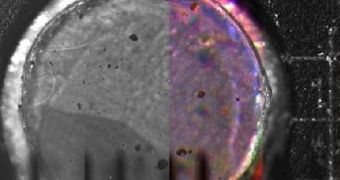This is the highest resolution image ever sent back to Earth by the Phoenix Mars Lander featuring dust and sand particles. The image was captured by the camera of the optical microscope instrument on board the spacecraft and shows particles of dust as small as one-tenth of the diameter of the human hair. The mission of the Phoenix Mars Lander is to study whether or not the Red Planet as we know it was ever habitable for life.
"We have images showing the diversity of mineralogy on Mars at a scale that is unprecedented in planetary exploration", said Michael Hecht from NASA's Jet Propulsion Laboratory in a media briefing.
Although the mission scientists were hoping to spot some of the first pieces of evidence of water ice during the session destined to test the capabilities of the microscope instrument, the images only revealed grains of mineral, most likely salt, and reddish and dark particles similar in color to the surface of Mars. Professor Tom Pike, Phoenix geology team leader from the Imperial College London, said that if ice had been present in the photographed samples, then it would have melted long before the pictures were taken.
This doesn't mean however that the possible discovery of salt is not an important finding. In fact, the microscope imaging tool was not designed with the exact purpose of finding water ice or any other signs of life on the Red Planet. This task is reserved for the TEGA analyzer and the robotic arm of the spacecraft.
After the radio instrument glitch suffered by the Mars Reconnaissance Orbiter in the first days of the mission, Phoenix was again commanded to take soil samples from the surface. Meanwhile, mission controllers carrying out tests with the robotic arm of the spacecraft were able to dig up a trench 3.8 centimeters in depth, revealing a subsurface layer that will probably be studied more closely during the 3 month mission.
The bright white spot under the lander, named by NASA the "Snow Queen" and suspected to be water ice, will not be sampled by Phoenix's robotic arm, since its scoop cannot reach it. Although NASA and the ESA have been probing Mars with a range of robotic aircrafts including rovers and orbiters for the last decade, there is still no direct evidence of water being present on the surface. The Phoenix mission was in fact encouraged by the detection of subsurface water by the Mars Odyssey orbiter in 2002.

 14 DAY TRIAL //
14 DAY TRIAL //